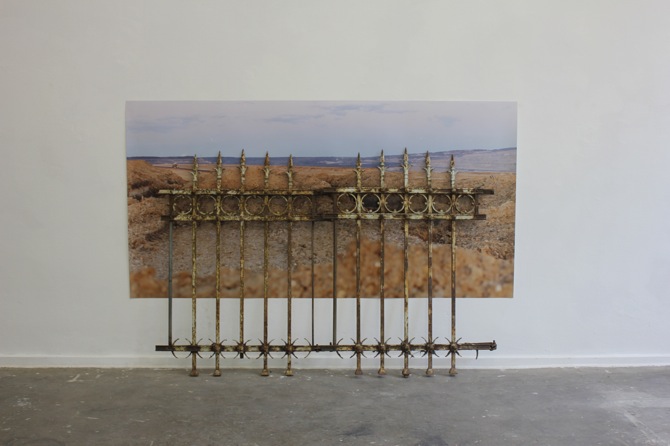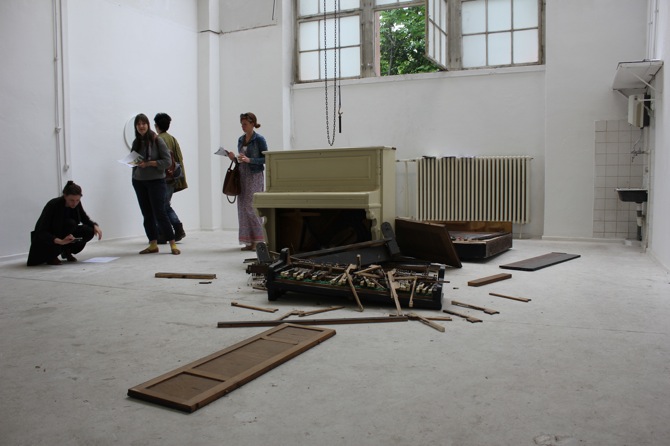 Katharina von Hagenow, Klasse Möbus, Raum 78
Katharina von Hagenow, Klasse Möbus, Raum 78
 Samuel Ash (Wooden sculpture), Katharina von Hagenow (sound sculptures), Klasse Möbus, Raum 77
Samuel Ash (Wooden sculpture), Katharina von Hagenow (sound sculptures), Klasse Möbus, Raum 77
 Julian Charrière, Klasse Olafur Eliasson, Raum 92
Julian Charrière, Klasse Olafur Eliasson, Raum 92
 Clara Thorbecke, Klasse Held
Clara Thorbecke, Klasse Held
 Leon Eisermann, Klasse Zipp, Raum 229
Leon Eisermann, Klasse Zipp, Raum 229
 Claudio Campo-Garcia, Klasse Lewandowsky
Claudio Campo-Garcia, Klasse Lewandowsky
 Juliane Tübke, Klasse Lewandowsky
Juliane Tübke, Klasse Lewandowsky
 Luca Vanello, Raum 94
Luca Vanello, Raum 94
 Fabian Knecht, Raum 91, curated by Lukas Töpfer
Fabian Knecht, Raum 91, curated by Lukas Töpfer
 Lilia Kovka, Raum 91, curated by Lukas Töpfer
Su Hwan Choi, Raum 91, curated by Lukas Töpfer
Lilia Kovka, Raum 91, curated by Lukas Töpfer
Su Hwan Choi, Raum 91, curated by Lukas Töpfer
 Franziska Nestler, Klasse Lorbeer, Raum 215
Franziska Nestler, Klasse Lorbeer, Raum 215
all images: courtesy the artists, photo copyright: artfridge
Berlin likes to flirt with the idea of being the most important art capital in the world – but whether this 'brilliancy' reflects on the young professionals, is best to be observed at the annual degree show of the Universität der Künste (UDK) – the "Rundgang", as we call it. Opening nine campus locations for a long weekend to the public, the fine art studios at Hardenbergstraße 33 are presumably the most popular highlight.
In the German art academy system, students are allocated to only one Professor, subsequently forming a class until they reach their final degree. At the time of the Rundgang it usually shows, which classes develop a coherent curatorial room concept and which ones simply demonstrate an assemblage of lone warriors. Since the latter unfortunately holds the majority, it is even more obvious how rarely students let their works benefit from their peer's art and from a collective room concept. The class of Prof. Ursula Neugebauer, for example, did this beautifully: Each work – from the squeezed fishes by Eugen Wist, to a minimalist sculpture by Lukas Troberg, to the stitched bird's wing by Eva Elisabeth Wallner – had space to breathe. The class of Prof. Via Lewandowsky demonstrated a similar approach and convinced with several high quality spaces. Especially an installation piece by Claudio Campo-Garcia, who re-staged a sort of 'party-is-over' scene, seemed ironically perfect for the event of the Rundgang.
Perhaps the most outstanding room concept was done by the external curator and art critic Lukas Töpfer, who assembled students from the Eliasson- and the Lewandowsky-class in Room 91. With a focus on balancing the quiet and the loud, Töpfer arranged Fabian Knecht's crashed pianos to by confronted with Lilia Kovka's photography that shows a tattoo saying "BAM". Then, out of the blue, the original sound of the collision bangs throughout the room. Next to Room 91, the second backyard bears also two interesting solo presentations: Luca Vanello, a former Gregor Schneider student, presents an autistic array of building construction material and Julian Charrière, an Olafur Eliasson student, installed a space that couldn't allegorize the idea of crumbling planet any better (and any more beautiful, either.)
The process of decay and destruction, whether in Campo-Garcia's, Charrière's or Knecht's work, seems to be a prominent theme of the Rundgang 2013. There is also a sense of that in the work "Haus Etzweiler" by Katharina von Hagenow (Klasse Prof. Möbus), who dedicates her photo installation to a city that was resettled due to the construction of a cole mine. Franziska Wildt (Klasse Prof. Favre), on the opposite, presents a photo installation that takes the aesthetic of constructions to a level romanticism.
The state between the past and the future – it seems – is a state of construction, of confusion and of not knowing what comes next. Artists, and especially the young ones, often have a good sense of incorporating a contemporary mood into their work. And thus the Rundgang of the UDK very much mirrors what Berlin really is, and not what it would like to be: A place of change. And a place of chance.
Rundgang 2013
12. - 14. Juli 2013 (Sunday: 11-20h)
UDK
Fine Arts / Architecture / Workshops
Hardenbergstr. 33
10623 Berlin
 Eugen Wist, Klasse Neugebauer, Raum 260
Eugen Wist, Klasse Neugebauer, Raum 260
 Eike von Vacano, Klasse Neugebauer, Raum 156
Eike von Vacano, Klasse Neugebauer, Raum 156
 Eva Elisabeth Wallner, Klasse Neugebauer, Raum 260
Eva Elisabeth Wallner, Klasse Neugebauer, Raum 260
 Lukas Troberg, Klasse Neugebauer, Raum 156
Lukas Troberg, Klasse Neugebauer, Raum 156
 Olivia Jasinski, Klasse Favre
Olivia Jasinski, Klasse Favre
 Klasse Manfred Pernice
Klasse Manfred Pernice
 Clemens Behr_Klasse Konrad
Clemens Behr_Klasse Konrad
 Installation view, Klasse Konrad
Installation view, Klasse Konrad
 Vivienne Appelius, Klasse Konrad, Raum 95
Vivienne Appelius, Klasse Konrad, Raum 95
 Aaron Rahe, Klasse Favre
Aaron Rahe, Klasse Favre
 Installation view, Klasse Favre
Installation view, Klasse Favre
 Franziska Wildt, Klasse Favre
Franziska Wildt, Klasse Favre
 Installation view, Klasse Favre, Raum 234
Installation view, Klasse Favre, Raum 234
 Malaika Neu, Klasse Lammert, Raum 117
Malaika Neu, Klasse Lammert, Raum 117
 Installation view, Klasse Fries
Installation view, Klasse Fries
 Solveig de Barry, Klasse Lucander, Raum 211
Solveig de Barry, Klasse Lucander, Raum 211
 Installation view, Klasse Ikemura
Installation view, Klasse Ikemura
 Johannes Fuchs, Klasse Ikemura
Johannes Fuchs, Klasse Ikemura
 Institut S 3000, Raum 135
Institut S 3000, Raum 135
 Annagul Beschareti, Klasse Lorenz, Raum 68 (Grundlehre)
Annagul Beschareti, Klasse Lorenz, Raum 68 (Grundlehre)
 Azusa Kuno, Meisterschüler Exhibit
Azusa Kuno, Meisterschüler Exhibit
 Diana Sprenger, Meisterschüler exhibit
Diana Sprenger, Meisterschüler exhibit
 Poster in front of Raum 229 (Klasse Zipp)
Poster in front of Raum 229 (Klasse Zipp)all images: courtesy the artists, photo copyright: artfridge
